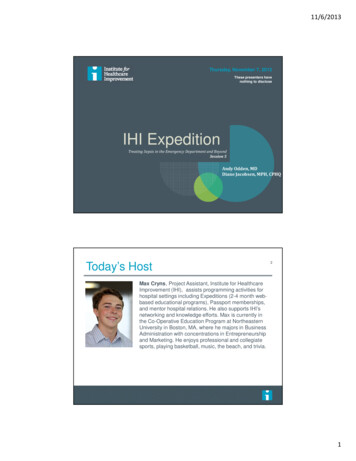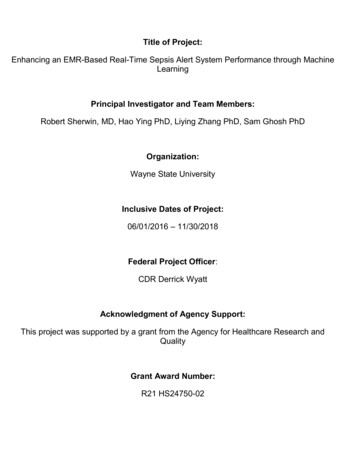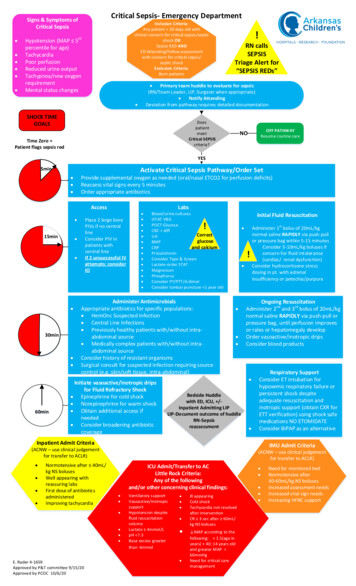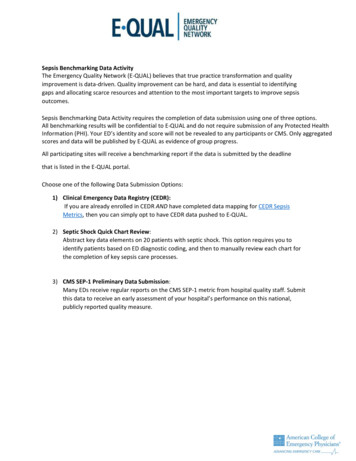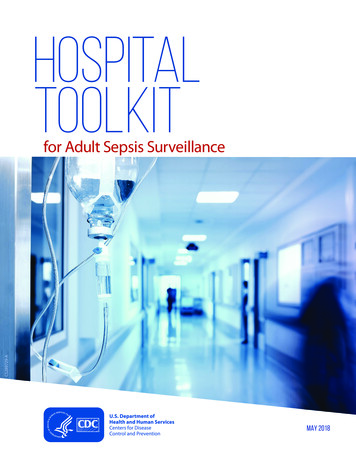
Transcription
HospitalToolkitfor Adult Sepsis SurveillanceMAY 2018
Centers for Disease Control and Prevention Division of Healthcare Quality Promotion
Table ofContentsList of Abbreviations 2Background 3Objectives 3Surveillance Settings and Appropriate Use 4Definitions 4ASE: Adult Sepsis Event 5BSE: Bacteremia/Fungemia Shock Event 6Key Terms and Concepts 6Blood Culture 6Window Period 6Qualifying Antimicrobial Days (QAD) 6Onset Date 8Community-Onset vs. Hospital-Onset Events 8Baseline Organ Function 9Repeat Infection Timeframe Considerations 9Surveillance Methods 10Pre-assessment of Sepsis Identification, Care and Surveillance Practices (Optional) 10Electronic Case Finding 11Manual Case Finding 11Denominator Data Collection 12Data Analysis and Quality Assessment 12References 13Appendices 14Appendix A. Antimicrobials Qualifying for Adult Sepsis Event 14Appendix B: Vasopressors Included in Adult Sepsis Event Definition 15Appendix C: Data Specifications for Direct Sepsis Determination from Electronic Health Records 15Appendix D: Adult Sepsis Event (ASE) Manual Case Report Template 22Appendix E: Adult Bacteremia/Fungemia Shock Event (BSE) Manual Case Report Template 26
List of Abbreviations2ASEadult sepsis eventICUintensive care unitBSEbacteremia/fungemia shock eventIVintravenousCDCCenters for Disease Control and PreventionNHSNNational Healthcare Safety NetworkCOcommunity-onsetQADqualifying antimicrobial daysCPTcurrent procedural terminology codePOoral administrationeGFRestimated glomerular filtration rateRITrepeat infection timeframeEDemergency departmentSEP-1EHRelectronic health recordCenters for Medicare & Medicaid ServicesEarly Management Bundle, SevereSepsis/Septic ShockHOhospital-onsetSOFASequential Organ Failure AssessmentICD-1010th Revision of the InternationalStatistical Classification of Diseasesand Related Health Problems
BackgroundSepsis is a clinical syndrome defined as life-threatening organ dysfunction caused by a dysregulated hostresponse to infection.1 The burden of sepsis is high, with over 1.7 million adult sepsis cases annually in the U.S.which contribute to 270,000 deaths.2 Patients who survive sepsis often suffer long-term physical, psychological,and cognitive disabilities.Because there is no confirmatory diagnostic test, the diagnosis of sepsis requires clinical judgment based onevidence of infection and organ dysfunction. A 1991 consensus conference established a clinical definition basedon the patient’s systemic inflammatory response syndrome (SIRS) to infection (later referred to as Sepsis-1)3, andthese clinical criteria were expanded in 2001 in the Sepsis-2 criteria.4 In response to increasing understandingof sepsis pathobiology, a task force updated the clinical definitions in 20161, and in Sepsis-3, defined sepsis as“life-threatening organ dysfunction caused by a dysregulated host response to infection”, with clinical guidelinesdefining organ dysfunction as acute change in total Sequential Organ Failure Assessment (SOFA) score 2 pointsconsequent to the infection.1The updated clinical definitions are critical for identifying patients at risk for sepsis and further complications, butthere is also a need for a definition that can be used to retrospectively track sepsis for rigorous case countingand outcome monitoring. Different definitions for sepsis are needed for different purposes, which could includeclinical care, research, surveillance, and quality improvement and audit.5,6 For example, a sepsis definitionoptimized for public health surveillance would prioritize reliability and validity across healthcare facilities, andlow measurement burden. However timeliness may be less of a priority because such definitions would be usedretrospectively and not be intended for clinical management of individual patients.5,6Prior to 2017, U.S. national estimates of sepsis burden primarily relied on the use of administrative codes, whichhave consistently demonstrated increasing incidence and decreasing mortality.7 Administrative codes arealso frequently used in sepsis quality initiatives, including the Centers for Medicare & Medicaid Services EarlyManagement Bundle, Severe Sepsis/Septic Shock (SEP-1). However, studies have demonstrated that coding forsepsis has steadily increased over the past decade, yet coding for the most common underlying infections hasbeen stable or decreasing.8 These analyses demonstrate that coding practices are likely vulnerable to biases fromincreasing sepsis awareness and financial incentives (higher reimbursement for sepsis coding), and thereforeunreliable for surveillance purposes.8In 2017, a CDC Prevention Epicenters-funded consortium published results of a study which used a newdefinition for sepsis based on objective clinical data elements conceptually analogous to Sepsis-3. Thisdefinition was optimized for surveillance directly from electronic health records (EHRs) across over 400 facilities,and displayed superior sensitivity and similar specificity compared to administrative codes when using Sepsis-3criteria determined by medical record reviews as a gold standard.2 Furthermore, this definition demonstratedthat national sepsis incidence and outcomes (combination of death and discharge to hospice) were stable from2009-2014, in contrast to administrative codes which showed increasing incidence and decreasing mortality,but are confounded by increasing sepsis awareness, coding bias, and financial incentives.ObjectivesThis toolkit allows healthcare professionals who are interested in using the sepsis surveillance methodology fromthe national burden study to track healthcare facility-level sepsis incidence and outcomes using an objectivedefinition based on clinical data. Necessary data may be obtained and processed directly from electronic healthrecord, but could also be obtained using manual chart review. These data may be useful for understanding theeffectiveness of local sepsis prevention, early recognition, and treatment programs.3
Surveillance Settings and Appropriate UseThese sepsis definitions were developed for surveillance of adult patents in acute care hospitals where denominatordata (total admissions or patient days) can be collected. Because this toolkit features sepsis definitions not subject tocoding bias or variation in provider documentation, it may be helpful for objectively tracking sepsis incidence andoutcomes within a facility for the purpose of quality improvement initiatives or public health and epidemiology.It is not recommended to use these definitions for sepsis surveillance among pediatric patients, since thesesurveillance definitions were developed to mirror adult sepsis definitions and have not been validated inpediatric populations.The following sepsis definitions are not intended to guide clinical diagnostic or therapeutic decision making.The antibiotic prescribing requirements to meet a sepsis case imply that patient can only meet one of the sepsissurveillance definitions after at least 4 days of antibiotic therapy, and therefore the determination of sepsis withthese definitions is retrospective.Hospitals serve a variety of different patient populations that vary by factors that influence patient outcomes,including sepsis risk factors, comorbidities, and acuity of illness. Therefore direct comparison of sepsis outcomesamong hospitals may not reflect quality of sepsis care. Rigorous comparisons of sepsis outcomes for regional,state, or national ranking purposes would require additional research to create validated risk adjustment modelsthat account for many patient and hospital-level factors. However, despite these limitations, these standardizedsurveillance definitions could be useful for comparing sepsis outcomes within the same hospital over time or to apeer institution serving a similar population.DefinitionsTwo sepsis events definitions are presented.The Adult Sepsis Event (ASE) captures the widest variety of sepsis patients. This definition was developedand tested in a study by Rhee, et al. which included more than 400 U.S. hospitals using a wide variety ofelectronic health records.2 ASE surveillance requires access to microbiology, medication administration,laboratory, and administrative (ICD) coding data. Clinical records of mechanical ventilation may also be usedin lieu of procedure codes.This definition was validated by Rhee, et al. and shown to be present in 6% of hospital admissions, with asensitivity of 69.7% (95% confidence interval [CI] 52.9% to 92.0%), 98.1% specificity (95% CI 97.7% to 98.5%),70.4% positive predictive value (95% CI 64.0% to 78.8%), and 98.0% negative predictive value (95% CI 95.9% to99.6%) when using Sepsis-3 criteria as the reference standard.2There is no single diagnostic test for sepsis, or one set of criteria that can identify sepsis with perfect accuracy, andthus it is important to note the following limitations of this surveillance definition, which has been optimized forobjectivity and standardization:§§While ASE is not subject to provider variation in documentation and coding of sepsis, it is still dependent on providerinitiated interventions (ordering blood cultures, antimicrobials, laboratory tests, vasopressors or mechanical ventilation) tomeasure presumed infection and organ dysfunction. This is also a limitation of the Sepsis-3 definition.§§It is not possible to determine whether organ dysfunction was a result of infection or other causes when using EHR-basedautomated determination of ASE. This can lead to misclassification.§§ASE criteria will miss organ dysfunction due to mild or moderate hypoxia that does not result in mechanical ventilation butwould fulfill organ dysfunction criteria in the Sepsis-3 clinical definition. It will also miss neurologic dysfunction that wouldfulfill Sepsis-3 criteria.4
The Bacteremia/Fungemia Shock Event (BSE) is a simplified definition that tracks a narrower sub-populationof patients with a much higher mortality. This definition is based on positive blood cultures (excluding commoncontaminants), which almost always reflect true infections, and vasopressors, which almost always reflect clinicallyimportant hypotension. BSE requires fewer data elements than ASE and can be determined using only microbiologyand medication administration recordsIn subsequent analysis of the dataset used by Rhee et al., BSE was present in 0.48% of hospital admissions (comparedto 6.0% with ASE), and 35.4% of BSE events resulted in death during hospitalization (compared to 15% of ASE). Ithad a sensitivity of 6.0% and positive predictive value of 100% when using Sepsis-3 criteria as the reference standard(unpublished).ASE: Adult Sepsis Event(Must include the 2 components of criteria A AND include one or more organ dysfunction listed among B criteria)A. Presumed Infection (presence of both 1 and 2):1. Blood culture obtained (irrespective of the result), AND2. At least 4 Qualifying Antimicrobial Days (QAD) – starting within the time period 2 calendar days beforeand 2 calendar days after the collection date of a blood culture. See below.ANDB. Organ Dysfunction (at least 1 of following criteria met within the time period 2 calendar days beforeand 2 calendar days after the collection date of a blood culture.):1. Initiation of a new vasopressor infusion (norepinephrine, dopamine, epinephrine, phenylephrine, ORvasopressin). To count as a new vasopressor, that specific vasopressor cannot have been administeredin the prior calendar day. Vasopressors given in an operating room or other procedural area should beexcluded. See Appendix B.2. Initiation of invasive mechanical ventilation (must be greater than 1 calendar day between mechanicalventilation episodes). Invasive mechanical ventilation can be identified by ICD-10 Procedure Codes(5A1935Z, 5A1945Z, 5A1955Z) or CPT codes (94002, 94003, 94004, 94656, 94657), or by other clinicalrecords.3. Doubling of serum creatinine OR decrease by 50% of estimated glomerular filtration rate (eGFR) relativeto baseline (see below), excluding patients with end-stage renal disease (which can be identified usingICD-10 codes [N18.6] or other clinical records). (If eGFR values are not readily available, creatinine alonecan be used to determine renal dysfunction).4. Total bilirubin 2.0 mg/dL and increase by 100% from baseline (see below).5. Platelet count 100 cells/µL AND 50% decline from baseline (see below) - baseline must be 100 cells/µL.6. Optional: Serum lactate 2.0 mmol/L. Note that serum lactate has become an increasingly commontest to measure tissue perfusion. When serum lactate is included in the surveillance definition, the likelyeffect will be to slightly increase the number of sepsis cases identified. However, if serum lactate orderingpractices are not stable over time in a particular hospital this will bias trends in the incidence of sepsis.For this reason, serum lactate was not used in the primary analysis of sepsis trends over time in the originalstudy by Rhee et al.5
BSE: Bacteremia/Fungemia Shock Event(Must meet BOTH criteria A AND B)A. Bacteremia OR FungemiaPatient has a recognized pathogen identified (i.e., an organism which is not a common commensal – seeCDC National Healthcare Safety Network list for guidance) from one or more blood specimens by a culture(non-culture based microbiologic testing methods could also be used to identify pathogens, but were notused in the initial study by Rhee et al.).ANDB. New VasopressorInitiation of a new vasopressor infusion (norepinephrine, dopamine, epinephrine, phenylephrine, vasopressin)within the time period 2 calendar days before and after the collection date of a blood culture demonstratinga recognized pathogen (see A). To count as a new vasopressor, that specific vasopressor cannot have beenadministered in the prior calendar day. Vasopressors given in an operating room or other procedural areashould be excluded.Key Terms and ConceptsBlood CultureQualifying cultures include those drawn for bacterial (aerobic and/or anaerobic), acid-fast bacilli (AFB), andfungal cultures. Blood cultures for specific viruses (e.g., cytomegalovirus) are excluded. For ASE, blood culturesmerely need to have been drawn, regardless of result. For BSE, blood cultures or other bacteremia or fungemiatesting of blood must have yielded a recognized pathogen.Window PeriodThe date the blood culture is obtained is the center of a window period extending both 2 days before and2 days after the blood culture for both ASE and BSE. Multiple window periods during a hospitalization arepossible. If multiple blood cultures are obtained in a short period of time, window periods may overlap.Figure 1: Examples Illustrating Window PeriodHospital Day No.Blood CultureWindow ospital Day No.Blood CultureWindow Period123456789A—————A——Hospital Day No.Blood CultureWindow PeriodWindow Period—Window Period AWindow Period apping Window PeriodsIf blood cultures, antimicrobial use, OR any organ dysfunction criteria are obtained on hospital day -1 orday 0 (i.e., up to 2 days prior to admission), these criteria can be used to qualify for events in order toaccount for medical care in the emergency department prior to admission.Qualifying Antimicrobial Days (QAD)For ASE events, the first QAD is the first day in the window period extending both 2 days before and 2 days afterthe patient receives a new antimicrobial (see Appendix A for list of qualifying antimicrobials). A new antimicrobialis defined as an antimicrobial not previously administered in the prior 2 calendar days. Oral and intravenousformulations of the same antimicrobial are counted as the same antimicrobial EXCEPT for vancomycin.6
Subsequent QADs can be the same antimicrobial, or a different antimicrobial as long as the first dose of eachantimicrobial in the sequence is new (not previously administered in the prior 2 calendar days). A subsequentnew antimicrobial does not have to be started within the window period to be counted as a QAD.Figure 2: Examples Illustrating QADHospital Day No.Blood CultureWindow PeriodLevofloxacin ——————Window Period————XXXX———XXXX—This scenario includes at least 4 QAD that begin within the window period, and therefore meets criteria for presumed infection.Hospital Day No.Blood CultureWindow PeriodVancomycin IVadministrationPiperacillin/TazobactamIV �———Window ��12345—This scenario includes at least 4 QAD from Vancomycin that begin within the window period, and therefore meets criteria forpresumed infection. Because Piperacillin/Tazobactam administration was administered prior to the window period, it does notqualify towards QADs.There must be at least one new parenteral (intravenous or intramuscular) antimicrobial administered withinthe window period for the QADs to satisfy the definition.Figure 3: Examples Illustrating QAD with Multiple AntimicrobialsHospital Day No.Blood CultureWindow PeriodVancomycin IVadministrationPiperacillin/TazobactamIV administrationLevofloxacin ��————Window �———XXX————345—12In this scenario, the first 3 QADs were met by vancomycin IV administration and piperacillin/tazobactam IV administration.QAD 4 and QAD 5 were met by levofloxacin oral administration. Subsequent QADs may be oral as long as at least one QADin the window period is parenteral. This scenario qualifies for presumed infection.A gap of a single calendar day between administrations of the same antibiotic (oral or intravenous) count asQADs as long as the gap is not greater than 1 day.7
Figure 4: Examples Illustrating QAD with Gaps in Antimicrobial DosingHospital Day No.Blood CultureWindow PeriodLevofloxacin ———————Window PeriodX—X—X————12345————Even though levofloxacin is administered every other day, because the gap between doses is only 1 day, this levofloxacin administrationcounts as consecutive treatment doses, for a total of at least 4 QAD that begin within the window period, and therefore meets criteriafor presumed infection.If a patient’ s care transitions to comfort measures only, or the patient dies, is discharged to another hospital,or discharged to hospice before 4 QADs have elapsed, then the presumed infection criteria can be met withless than 4 QADs as long as they have consecutive QADs until day of, or 1 day prior to, death or discharge tohospice/other hospital or transition to comfort measures. For a patient only seen in the ED or ED observationunit, a QAD is required each day until day of, or 1 day prior to, death.QAD does not apply to BSE events since administration of antibiotics is not required to meet the definition.Figure 5: Example Illustrating QAD with Patient DeathHospital Day No.Blood CultureWindow PeriodLevofloxacin ——XWindow Period—Even though only 2 QADs had elapsed before patient death, this scenario counts as an event since there were consecutive QADs untilthe day prior to death.Onset DateFor ASE, onset date is defined as the earliest day in the window period extending both 2 days before and 2 daysafter the blood culture when EITHER the blood culture, first QAD, OR organ dysfunction criteria is met. For BSE,onset date is defined as the earliest day in the window period extending both 2 days before and 2 days after theblood culture when the vasopressor infusion was started.Figure 6: Examples Illustrating Onset DateHospital Day No.Blood CultureWindow PeriodQADOrgan DysfunctionOnset dow �——X——————Organ dysfunction takes place on hospital day 3, while blood cultures and QADs begin on hospital-day 4. Because onset date is thedate of the first criteria met (in this case organ dysfunction), onset date is hospital day 3.Community-Onset vs. Hospital-Onset EventsHospital-Onset Events require onset date to be on hospital day 3 or later, counting the date of admission ashospital day 1. Community-Onset Events require onset date to be on hospital day 2 or earlier, when the date ofadmission counts as hospital day 1.8
Figure 7: Examples Illustrating Community-Onset vs. Hospital-Onset EventsHospital Day No.Blood CultureWindow PeriodQADOrgan DisfunctionOnset dow ��——————Because Onset Date is on hospital day 3, this example qualifies as a Hospital-Onset EventHospital Day No.Blood CultureWindow PeriodQADOrgan DisfunctionOnset —Window ��—————In this similar scenario, since the Organ Dysfunction was on hospital day 2, the Onset Date is also hospital day 2, and therefore thisexample qualifies as a Community-Onset Event.Baseline Organ FunctionCommunity-Onset Infection Events (Blood culture or first QAD on hospital day 1 or 2)§§Creatinine baseline is the lowest value during hospitalization.§§Estimated Glomerular Filtration Rate (eGFR) baseline is the highest value during the hospitalization.If eGFR value is documented as “ 60”, eGFR is treated as 60.§§Bilirubin baseline is the lowest value during hospitalization.§§Platelet baseline is the highest value during hospitalization. If all platelet counts during hospitalization are 100 cells/μL, then platelet count should not be used to satisfy organ dysfunction criteria.Hospital-Onset Infection Events (Blood culture and first QAD on hospital day 3 or later)§§Creatinine baseline is the lowest value within the window period extending both 2 days before and 2days after the date of blood culture collection.§§Estimated Glomerular Filtration Rate (eGFR) baseline is the highest value within the window periodextending both 2 days before and 2 days after the date of blood culture collection. If eGFR value isdocumented as “ 60”, eGFR is treated as 60.§§.Bilirubin baseline is the lowest value within the window period extending both 2 days before and 2 daysafter the date of blood culture collection.§§.Platelet baseline is the highest value within the window period extending both 2 days before and 2 daysafter the date of blood culture collection, AND must be 100 cells/μL. If all platelet counts within windowperiod are 100 cells/μL, then platelet count should not be used to satisfy organ dysfunction criteria.Repeat Infection Timeframe ConsiderationsThe repeat infection timeframe (RIT) is a timeframe after an ASE or BSE onset date when no new events arecounted, in order to minimize the chance a single, prolonged episode of ASE or BSE is counted twice.RIT therefore only applies to determination of hospital-onset events.Note that in Rhee et al., only one sepsis episode was counted per hospitalization, and thus no RIT was use
Sepsis is a clinical syndrome defined as life-threatening organ dysfunction caused by a dysregulated host . response to infection. 1 The burden of sepsis is high, with over 1.7 million adult sepsis cases annually in the U.S. . outcomes within a facility for the purpose of quality improvement initiatives or public health and epidemiology.
